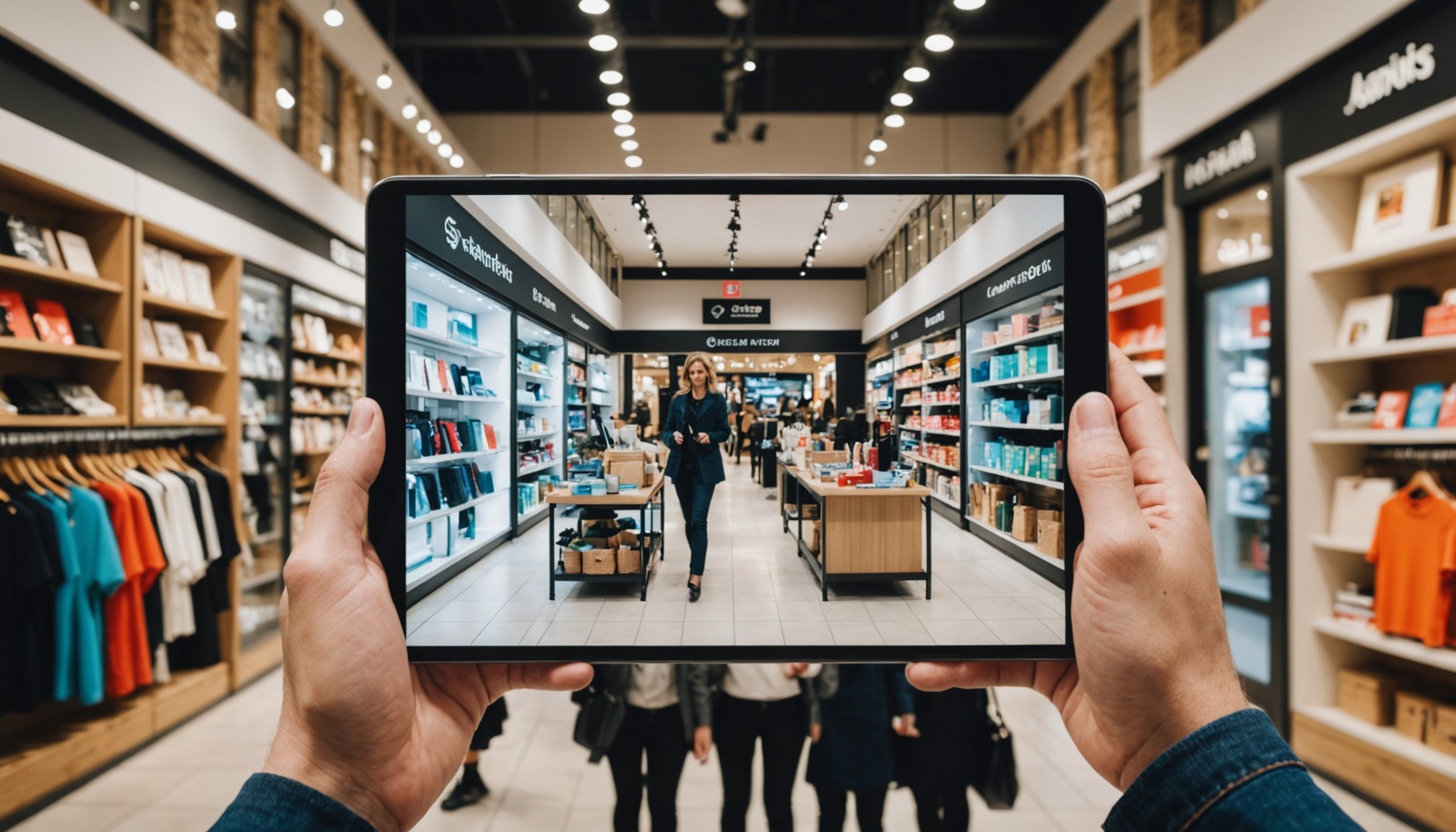Overview of Augmented Reality in Retail
Augmented Reality (AR) is revolutionising the retail sector by seamlessly blending digital elements with the physical world, creating a more immersive and interactive customer experience. This retail innovation allows businesses to enhance their shopping environments and, ultimately, boost customer satisfaction.
In practical terms, AR improves the customer experience by enabling shoppers to visualise products in real-world settings. For instance, customers can use their smartphones to see how a piece of furniture might look in their living room or try on virtual clothing in-store or online. This level of engagement not only bolsters customer confidence in purchasing decisions but also reduces returns, a significant benefit for retailers.
Have you seen this : Unlocking AI Potential: Proven Strategies for UK Telecoms to Enhance Network Performance
Research highlights the growing adoption of AR in retail, particularly within the UK. A recent survey revealed that over 60% of UK retailers have incorporated AR into their shopping experiences, and many are seeing significant returns on investment. This substantial uptake underscores the importance of AR as a tool not just for enhancing customer engagement but also for staying competitive in an evolving market. As this technology continues to grow, it represents a key strategy for retailers aiming to improve their service offering in an increasingly digital landscape.
Successful Implementations of AR in UK Retail
Augmented reality (AR) continues to transform UK retail landscapes, offering notable examples of success through innovative implementations. A standout case is IKEA, leveraging AR with their app, allowing customers to place virtual furniture in their homes. This feature significantly improved customer engagement by visualising products in real-life contexts, boosting confidence in purchasing decisions and subsequently increasing sales.
Topic to read : Unlocking Collaboration: How Co-Working Spaces Propel Networking and Growth for UK Startups
Similarly, L’Oréal has enriched the shopping experience by introducing a virtual try-on feature for cosmetics. This AR innovation has been well-received, capturing positive customer feedback and stimulating higher conversion rates online. The seamless integration of this technology in their strategy has not only enhanced user satisfaction but also led to a significant uplift in customer retention.
Lastly, ASOS stands as a model for AR implementation, introducing virtual catwalks and 3D product previews, resonating particularly well with their tech-savvy audience. The outcome of their strategy showcased a surge in online engagement and an increase in sales.
These examples highlight how UK retailers can successfully incorporate AR into their business models, focusing on increasing both customer satisfaction and sales through personalised and innovative shopping experiences. It demonstrates the practicality and profitability of AR when thoughtfully embedded into retail strategies.
Actionable Strategies for UK Retailers
The implementation of AR strategies in retail accelerates the transformation of the shopping landscape. A methodical approach begins with understanding customer needs and identifying the areas where AR can create maximum impact. Start by analysing consumer engagement patterns and determining which product lines might benefit from augmented reality features.
Step-by-step guide for implementing AR features:
- Identify Objectives: Establish clear goals for AR use, focusing on enhancing the customer experience and increasing engagement.
- Choose the Right Technology: Opt for AR platforms that align with your business needs. Popular tools like ARKit for iOS and ARCore for Android offer robust frameworks for development.
- Design User-Friendly Experiences: The AR interface should be intuitive. Ensure customers can easily access and use the technology in-store or via mobile apps.
- Integrate Seamlessly: Ensure AR tools work harmoniously with existing systems to provide a consistent shopping experience.
Best practices involve testing AR features extensively before launching. Solicit customer feedback to refine the user experience, and train staff to assist customers effectively. Expanding AR tools with analytics integration allows for tracking engagement and tailoring experiences to shopper behaviour. This data-driven approach ensures continuous improvement and optimises AR applications for sustainable growth.
Potential Challenges in AR Adoption
Augmented reality (AR) is a compelling tool in retail, yet its implementation is not without challenges. Retailers often face technical hurdles when integrating AR into their systems. Ensuring that AR applications work seamlessly with existing platforms can be daunting. Retail technology must support high-quality graphics and real-time data processing, which requires robust infrastructure and ongoing maintenance.
Financial considerations also play a significant role. Investing in AR technology can place a considerable strain on a retailer’s budget. The costs include developing AR features, maintaining them, and possibly upgrading hardware to support these innovations. Retailers must weigh these costs against potential benefits to make informed decisions.
Moreover, there tends to be resistance to change among staff and customers. Employees may require comprehensive training to effectively use and promote AR technology. Customers, on the other hand, might hesitate to adopt new ways of shopping. Retailers should focus on demonstrating the value of AR to alleviate these concerns and smooth the transition.
Addressing these challenges requires strategic planning, clear communication, and a willingness to adapt. By proactively managing obstacles, retailers can harness the full potential of AR to enhance the customer experience and drive retail innovation.
Benefits of Augmented Reality for Retailers
Augmented Reality (AR) offers a myriad of benefits for retailers, primarily in enhancing customer engagement and overall shopping satisfaction. By allowing customers to visualise how products fit into their lives, AR deepens customer interaction and improves decision-making. This not only elevates satisfaction but can also foster customer loyalty, as shoppers appreciate the personalised, immersive experience.
Another key advantage is product visualisation. AR transforms how customers perceive products, offering virtual previews that lead to increased confidence and potentially higher sales. For instance, seeing a sofa in a virtual living room setting can assure a customer of its fit and aesthetic appeal, making them more likely to complete a purchase.
AR further enhances the shopping experience by offering personalised experiences. The technology allows for customising shopping paths, tailoring content to individual preferences, and providing recommendations based on previous interactions.
Retail enhancement through AR represents a strategic advantage in today’s competitive market. Retailers who adopt AR can differentiate themselves, ensuring they meet evolving customer expectations and driving repeat business. Focusing on these benefits, retailers can leverage AR to strengthen their brand and cultivate a dedicated customer base.
Future Trends in Augmented Reality for Retail
The field of Augmented Reality (AR) is rapidly evolving, presenting innovative opportunities for the retail industry. It’s crucial for retailers to stay ahead by understanding the AR trends that will shape the future.
Emerging technologies such as Artificial Intelligence and machine learning are pivotal to advancing AR capabilities. These technologies enable more sophisticated AR applications, improving image recognition and enhancing the personalisation of shopping experiences.
Predictions for AR involve developing seamless, immersive experiences, allowing consumers to engage with products more intuitively. The integration of 3D graphics and real-time interactivity further elevates these experiences, offering an unprecedented level of immersion in the shopping environment.
Consumer behaviour is shifting towards a preference for immersive and interactive shopping experiences. Retailers leveraging AR are well-placed to meet these evolving demands, capturing the attention of tech-savvy customers.
We anticipate the widespread adoption of AR in retail will result in increased reliance on data analytics. Retailers can use this data to fine-tune AR applications and personalise customer interactions.
Tracking these future trends and embracing AR innovations will be essential for retailers aiming to maintain a competitive edge in a technologically advancing marketplace.
Recommendations for Retailers Adopting AR
Adopting Augmented Reality (AR) in retail necessitates strategic planning to ensure effectiveness and sustainable growth. The first consideration is evaluating the business’s readiness for AR integration. Retailers should assess their digital infrastructure and resource availability to support AR technology. Adequate preparation reduces integration hiccups and maximizes AR benefits.
A crucial element in AR strategy is data analytics. Employ tools that track customer engagements and measure the success of AR experiences. This data-driven approach allows retailers to fine-tune their AR applications, ensuring they meet consumer needs and enhance engagement. A proactive stance on continuous improvement will drive retail innovation and long-term success.
Retailers are also encouraged to foster a culture of continuous learning and innovation. Invest in training programs to equip staff with necessary AR skills and prepare them to offer customers effective assistance. Engaging staff in this digital shift ensures a smoother adoption and better customer interactions.
Prioritizing customer experience is essential. Retailers should focus on creating intuitive, immersive AR environments that resonate with their audience. By staying abreast of retail technology trends and effectively applying implementation best practices, retailers can maintain a competitive edge and deliver captivating shopping experiences.











